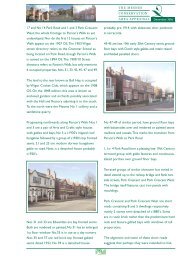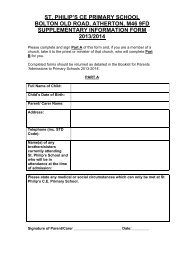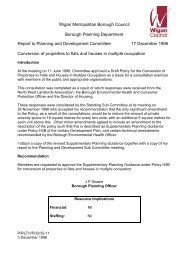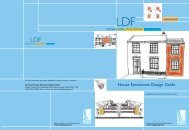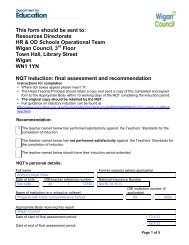Level 2 Strategic Flood Risk Assessment (.pdf ... - Wigan Council
Level 2 Strategic Flood Risk Assessment (.pdf ... - Wigan Council
Level 2 Strategic Flood Risk Assessment (.pdf ... - Wigan Council
Create successful ePaper yourself
Turn your PDF publications into a flip-book with our unique Google optimized e-Paper software.
The key objectives of a SFRA are to:Investigate and identify the extent and severity of flood risk to the area at present andin the future, under the terms of PPS25,Contribute to the <strong>Council</strong>’s Sustainability Appraisal (SA) and LDF,Enable the <strong>Council</strong> to apply the Sequential Test and assess the likelihood ofdevelopment passing the Exception Test,Provide strategic flood risk guidance and advice to planners and developers,Help LPAs to identify specific locations where further and more detailed flood riskdata and assessment work is required. This includes the scope for Surface WaterManagement Plans (SWMPs) and/or Water Cycle Studies (WCSs),Identify the level of detail required for site-specific <strong>Flood</strong> <strong>Risk</strong> <strong>Assessment</strong>s (FRAs),Inform the emergency planning process,Improve stakeholder joint working and the sharing of data, information and theunderstanding of flood risk, andProvide a reference document.There is a trend developing since the publication of the PPS25 Practice Guide in 2008 forSFRAs to be more than a land use planning tool and provide a broader and inclusive vehiclefor integrated, strategic and local flood risk management assessment and delivery. Sincepublication of the Pitt Review, it is apparent that SFRAs will provide the central store for data,information and consideration for all flood risk issues from all sources at a local level andprovide the linkage between Catchment <strong>Flood</strong> Management Plans (CFMPs), ShorelineManagement Plans (SMPs), Regional <strong>Flood</strong> <strong>Risk</strong> Appraisals (RFRAs), SWMPs andappropriate sustainable land uses over a number of planning cycles.SFRAs need to be fit for the future to help inform communities to meet the considerable floodrisk management and climate change related challenges ahead.1.3 <strong>Level</strong> 2 SFRA scope and objectivesThe <strong>Level</strong> 2 SFRA provides a detailed understanding of flood risk across <strong>Wigan</strong> borough fromall sources to help support the application of the Sequential Test and provide an assessmentof the likelihood of a site passing the Exception Test. This document provides anunderstanding of actual risk (taking into account the presence of flood defences) andidentifies residual risk. Residual risks are the risks that remain after all risk avoidance,substitution, control and mitigation measures have been taken into account. The residualrisks in <strong>Wigan</strong> are therefore related to the occurrence of events of low probability, such asextreme flood events greater than the design capacity of the constrained river system orfailure of flood defences or other assets (e.g. culverts, canals).It is the assessment of residual risk associated with low probability but high impact eventsthat is central to the <strong>Level</strong> 2 SFRA work and the impacts they have on the spatialdevelopment in <strong>Wigan</strong>. By facilitating the application of the Exception Test, the <strong>Level</strong> 2 SFRAtechnical work also provides evidence to support the allocation of land for specific uses withinindividual developments in flood risk areas, including providing a range of possible mitigationmeasures that could enable development to proceed.Whilst the application of the Exception Test may make it possible to strategically plan the typeand form of the development, it must not be used as a tool to place inappropriatedevelopment in flood risk areas.2009s0578 Final SFRA with Environment Agency Comments - L2 Ver5 <strong>Wigan</strong>.doc 6








